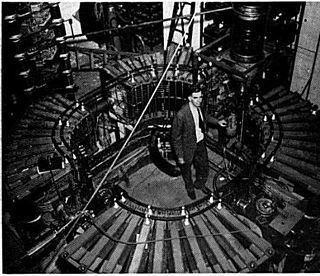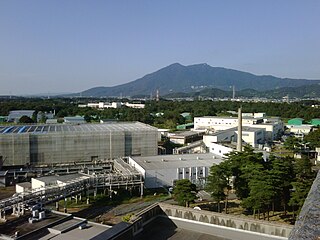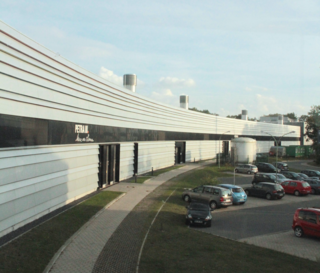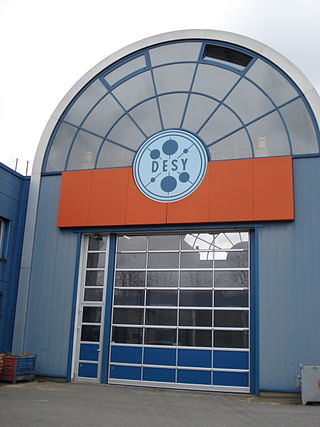
Particle physics or high-energy physics is the study of fundamental particles and forces that constitute matter and radiation. The field also studies combinations of elementary particles up to the scale of protons and neutrons, while the study of combination of protons and neutrons is called nuclear physics.

DESY, short for Deutsches Elektronen-Synchrotron, is a national research centre for fundamental science located in Hamburg and Zeuthen near Berlin in Germany. It operates particle accelerators used to investigate the structure, dynamics and function of matter, and conducts a broad spectrum of interdisciplinary scientific research in four main areas: particle and high energy physics; photon science; astroparticle physics; and the development, construction and operation of particle accelerators. Its name refers to its first project, an electron synchrotron. DESY is publicly financed by the Federal Republic of Germany and the Federal States of Hamburg and Brandenburg and is a member of the Helmholtz Association.

Diamond Light Source is the UK's national synchrotron light source science facility located at the Harwell Science and Innovation Campus in Oxfordshire.

A synchrotron is a particular type of cyclic particle accelerator, descended from the cyclotron, in which the accelerating particle beam travels around a fixed closed-loop path. The magnetic field which bends the particle beam into its closed path increases with time during the accelerating process, being synchronized to the increasing kinetic energy of the particles. The synchrotron is one of the first accelerator concepts to enable the construction of large-scale facilities, since bending, beam focusing and acceleration can be separated into different components. The most powerful modern particle accelerators use versions of the synchrotron design. The largest synchrotron-type accelerator, also the largest particle accelerator in the world, is the 27-kilometre-circumference (17 mi) Large Hadron Collider (LHC) near Geneva, Switzerland, built in 2008 by the European Organization for Nuclear Research (CERN). It can accelerate beams of protons to an energy of 7 tera electronvolts (TeV or 1012 eV).

The High Energy Accelerator Research Organization, known as KEK, is a Japanese organization whose purpose is to operate the largest particle physics laboratory in Japan, situated in Tsukuba, Ibaraki prefecture. It was established in 1997. The term "KEK" is also used to refer to the laboratory itself, which employs approximately 695 employees. KEK's main function is to provide the particle accelerators and other infrastructure needed for high-energy physics, material science, structural biology, radiation science, computing science, nuclear transmutation and so on. Numerous experiments have been constructed at KEK by the internal and international collaborations that have made use of them. Makoto Kobayashi, emeritus professor at KEK, is known globally for his work on CP-violation, and was awarded the 2008 Nobel Prize in Physics.

HERA was a particle accelerator at DESY in Hamburg. It was operated from 1992 to 30 June 2007. At HERA, electrons or positrons were brought to collision with protons at a center-of-mass energy of 320 GeV. HERA was used mainly to study the structure of protons and the properties of quarks, laying the foundation for much of the science done at the Large Hadron Collider (LHC) at the CERN particle physics laboratory today. HERA is the only lepton–proton collider in the world to date and was on the energy frontier in certain regions of the kinematic range.
A particle beam is a stream of charged or neutral particles. In particle accelerators, these particles can move with a velocity close to the speed of light. There is a difference between the creation and control of charged particle beams and neutral particle beams, as only the first type can be manipulated to a sufficient extent by devices based on electromagnetism. The manipulation and diagnostics of charged particle beams at high kinetic energies using particle accelerators are main topics of accelerator physics.

The Positron–Electron Tandem Ring Accelerator (PETRA) is one of the particle accelerators at the German national laboratory DESY in Hamburg, Germany. At the time of its construction, it was the biggest storage ring of its kind and still is DESY's second largest synchrotron after HERA. PETRA's original purpose was research in elementary particle physics. From 1978 to 1986, it was used to study electron–positron collisions with the four experiments JADE, MARK-J, PLUTO and TASSO. The discovery of the gluon, the carrier particle of the strong nuclear force, by the TASSO collaboration in 1979 is counted as one of the biggest successes. PETRA was able to accelerate electrons and positrons to 19 GeV.

ZEUS was a particle detector at the HERA particle accelerator at the German national laboratory DESY in Hamburg. It began taking data in 1992 and was operated until HERA was decommissioned in June 2007. The scientific collaboration behind ZEUS consisted of about 400 physicists and technicians from 56 institutes in 17 countries.
FLASH, acronym of Free Electron LASer in Hamburg, is a superconducting particle accelerator-based soft X-ray free-electron laser located at the German national laboratory DESY in Hamburg, Germany. It can generate very powerful, ultrashort pulses (~10−14 s) of coherent radiation in the energy range from 10 eV (electronvolt) to 300 eV. It started operation for external users in the year 2005 and is used for surface, molecular and atomic physics experiments. Intended applications are also the imaging of single biological complex molecules with time resolution.
Bjørn Håvard Wiik was a Norwegian elementary particle physicist, noted for his role on the experiment that produced the first experimental evidence for gluons and for his influential role on later accelerator projects. Wiik was director of DESY, in Hamburg, Germany, from 1993 until his death.

A particle accelerator is a machine that uses electromagnetic fields to propel charged particles to very high speeds and energies, and to contain them in well-defined beams.

A storage ring is a type of circular particle accelerator in which a continuous or pulsed particle beam may be kept circulating typically for many hours. Storage of a particular particle depends upon the mass, momentum and usually the charge of the particle to be stored. Storage rings most commonly store electrons, positrons, or protons.

The Helmholtz-Zentrum Dresden-Rossendorf (HZDR) is a Dresden-based research laboratory. It conducts research in three of the Helmholtz Association's areas: materials, health, and energy. HZDR is a member of the Helmholtz Association of German Research Centres.
NINA (Northern Institute's Nuclear Accelerator) was a particle accelerator located at Daresbury Laboratory, UK that was used for particle physics and as a source of synchrotron radiation.
Paul Heinrich Söding is a German physicist. He is best known for his work in particle physics and as former director of research of the German particle physics lab DESY.

The Helmholtz Institute Jena was founded as an outstation of the GSI Helmholtzzentrum für Schwerionenforschung on June 25, 2009 and is located on the campus of the Friedrich Schiller University (FSU) in the city of Jena, Germany. Its purpose is to unite the research activities of the FSU in the fields of high intensity laser physics and x-ray spectroscopy with the expertise of the Deutsches Elektronen-Synchrotron (DESY), GSI Helmholtzzentrum für Schwerionenforschung and Helmholtz-Zentrum Dresden-Rossendorf in the fields of accelerator physics, laser physics and x-ray technology. The research profile of the Helmholtz Institute Jena is focused on the physics occurring at the border between conventional particle-acceleration technology and the fast-evolving field of laser-induced particle acceleration.. It is concerned with advancing these new laser-induced accelerator concepts, as well as with the production and investigation of intense photon and particle beams, including their interaction with matter. Therefore the main activities of the institute are emphasized on the development of high intensity lasers, new concepts for laser-driven particle acceleration, x-ray spectroscopy and strong-field quantum electrodynamics, as well as on the physics of hot dense plasmas. Apart from that the Helmholtz Institute Jena aims to contribute to the further development of the research facilities at the Helmholtz center GSI, especially the future project FAIR, and DESY with the free-electron laser (FEL) photon sources FLASH and XFEL . In cooperation with the FSU Jena a completely diode-pumped laser system of the high energy petawatt class (HEPW) with the POLARIS laser is realized in the building of the Helmholtz Institute Jena. First measurements are done since 2008. Due to the missing last amplifier stage the pulse strength of 1 PW couldn't be reached yet. The graduate school "Research School for Advanced Photon Science" (RS-APS) was established at the Helmholtz Institute Jena in July 2012. The RS-APS supports up to 25 PhD students and provides a structured graduation program in cooperation with facilities of the FSU Jena and the Helmholtz Graduate School for Hadron and Ion Research (HGS-HIRe).

The Large Hadron Electron Collider (LHeC) is an accelerator study for a possible upgrade of the existing LHC storage ring - the currently highest energy proton accelerator operating at CERN in Geneva. By adding to the proton accelerator ring a new electron accelerator, the LHeC would enable the investigation of electron-proton and electron-ion collisions at unprecedented high energies and rate, much higher than had been possible at the electron-proton collider HERA at DESY at Hamburg, which terminated its operation in 2007. The LHeC has therefore a unique program of research, as on the substructure of the proton and nuclei or the physics of the newly discovered Higgs boson. It is an electron–ion collider, similar to the plans in the US and elsewhere, although the present design would not include polarized protons.

The LEP Pre-Injector (LPI) was the initial source that provided electrons and positrons to CERN's accelerator complex for the Large Electron–Positron Collider (LEP) from 1989 until 2000.
The Double-Ring Storage Facility (DORIS) was an electron–positron storage ring at the German national laboratory DESY. It was DESY's second circular accelerator and its first storage ring, with a circumference of nearly 300 m. After construction was completed in 1974, DORIS provided collision experiments with electrons and their antiparticles at energies of 3.5 GeV per beam. In 1978, the energy of the beams was raised to 5 GeV each.















